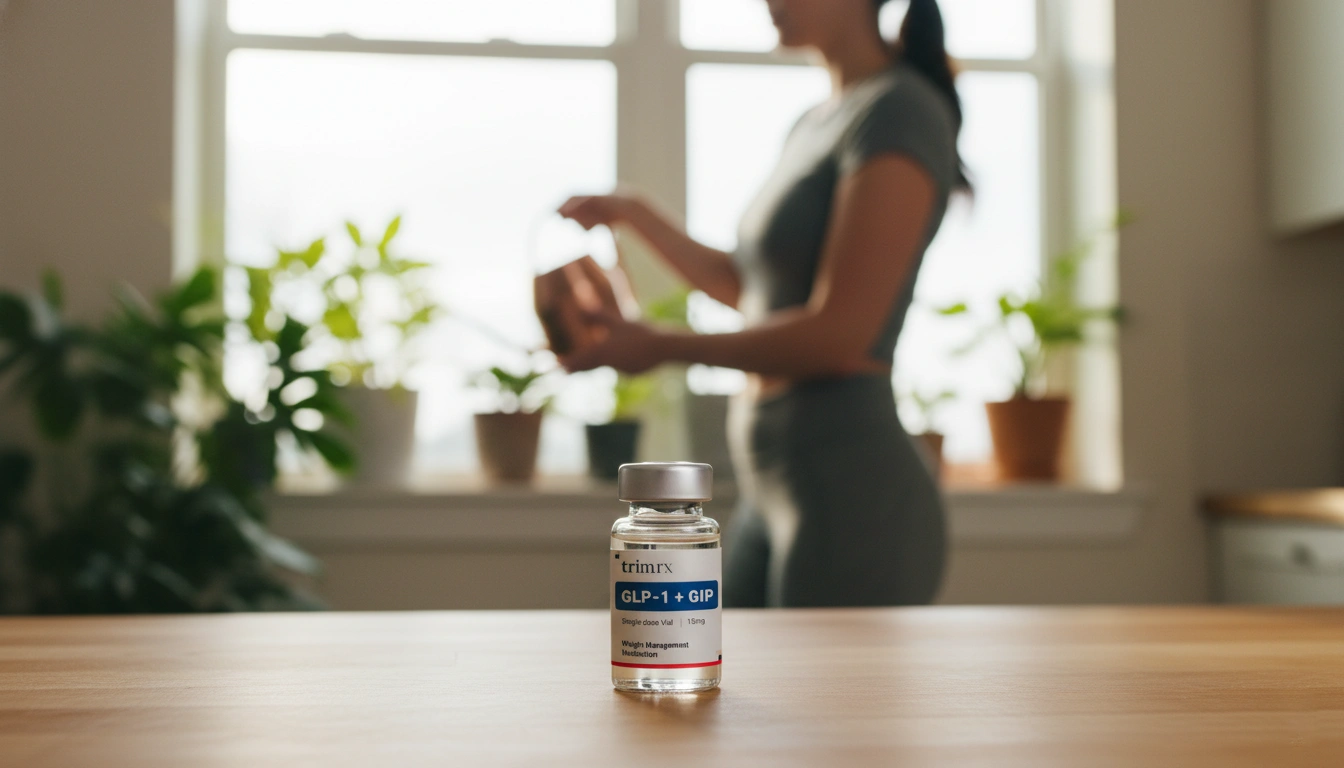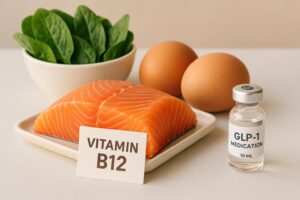How Your Body Makes GLP-1: The Key to Appetite Control and Weight Management

Introduction
Did you know that a single hormone could play a pivotal role in managing your hunger and regulating your blood sugar levels? This hormone, known as glucagon-like peptide-1 (GLP-1), is a game changer in understanding how our bodies communicate the need for food and manage energy intake. In recent years, GLP-1 has gained significant attention, especially with the rise of medications that mimic its effects for weight management and diabetes control.
Our exploration of how GLP-1 is produced in the body, its functions, and how we can naturally enhance its secretion is essential for anyone looking to understand their weight loss journey better. This blog post will delve into the fascinating world of GLP-1, how it is made, and the dietary and lifestyle factors that can influence its levels.
By the end of this post, you’ll have a comprehensive understanding of GLP-1’s role in appetite regulation, how to boost its production naturally, and how our personalized weight loss solutions at TrimRx can support your health journey. Together, we’ll explore the science behind GLP-1 and how embracing healthier lifestyle choices can empower you in your weight management efforts.
What is GLP-1?
GLP-1 is a hormone produced in the gastrointestinal tract, specifically within the L-cells of the small intestine. It is classified as an incretin hormone, which means it is released in response to food intake and plays a crucial role in regulating blood sugar levels. When we consume food, GLP-1 is secreted into the bloodstream, where it stimulates insulin release from the pancreas, slows gastric emptying, and promotes a feeling of fullness.
The Role of GLP-1 in the Body
GLP-1 has several critical functions, including:
-
Stimulating Insulin Secretion: GLP-1 enhances the secretion of insulin in response to meals, helping to lower blood glucose levels.
-
Inhibiting Glucagon Release: By reducing the release of glucagon (a hormone that raises blood glucose levels), GLP-1 helps maintain balanced blood sugar levels.
-
Slowing Gastric Emptying: GLP-1 slows the rate at which food leaves the stomach, leading to prolonged satiety after meals.
-
Regulating Appetite: GLP-1 acts on the brain’s appetite centers, promoting feelings of fullness and reducing food intake.
-
Potential Cardiovascular Benefits: Emerging research suggests that GLP-1 may have protective effects on heart health, although further studies are needed to confirm these benefits.
These functions highlight GLP-1’s vital role in managing not only hunger and food intake but also overall metabolic health.
How Does Your Body Make GLP-1?
The production of GLP-1 begins with the pre-proglucagon molecule, which is processed in the L-cells of the intestine. This process involves several steps:
1. Synthesis of Pre-Proglucagon
The gene responsible for producing GLP-1, called the proglucagon gene, is expressed in the L-cells of the intestine. This gene undergoes transcription and translation to form the precursor molecule called pre-proglucagon.
2. Processing Pre-Proglucagon
Once synthesized, pre-proglucagon is subjected to post-translational modifications, where it is cleaved to produce several bioactive peptides, including GLP-1. This processing is facilitated by specific enzymes, and it occurs primarily in response to nutrient intake.
3. Secretion into the Bloodstream
After its synthesis, GLP-1 is released into the bloodstream in response to food consumption. The secretion of GLP-1 typically begins about 10-15 minutes after eating and remains elevated for several hours, depending on the composition of the meal.
Factors Influencing GLP-1 Production
Several factors can influence the production and secretion of GLP-1, including:
-
Nutrient Composition: The types of foods we eat can significantly affect GLP-1 release. Meals rich in protein, fiber, and healthy fats have been shown to stimulate greater GLP-1 secretion.
-
Meal Size and Frequency: Larger meals tend to provoke a more substantial GLP-1 response compared to smaller meals. Additionally, more frequent meals can lead to higher baseline levels of GLP-1.
-
Gut Microbiota: The composition of gut bacteria can also influence GLP-1 secretion. A healthy gut microbiome may enhance the release of GLP-1 through the fermentation of dietary fibers.
Natural Ways to Boost GLP-1 Levels
Understanding how to enhance your body’s natural production of GLP-1 can be beneficial for managing appetite and supporting weight loss. Here are several effective strategies to boost GLP-1 levels naturally:
1. Increase Fiber Intake
Fiber-rich foods can stimulate GLP-1 secretion by promoting fermentation in the gut, which produces short-chain fatty acids that signal L-cells to release GLP-1. Foods high in fiber include:
-
Whole Grains: Oats, barley, and quinoa are excellent sources of soluble fiber that can enhance GLP-1 release.
-
Fruits and Vegetables: Incorporating a variety of fruits and vegetables into your diet not only provides fiber but also essential vitamins and minerals that support overall health.
-
Legumes: Beans, lentils, and chickpeas are rich in both fiber and protein, making them ideal for enhancing GLP-1 levels.
2. Opt for Healthy Fats
Healthy fats, such as those found in avocados, nuts, and olive oil, can also stimulate GLP-1 secretion. These fats help slow digestion and promote satiety, ultimately supporting weight management.
3. Incorporate Protein
Including adequate protein in your meals can lead to increased GLP-1 levels. Foods like eggs, lean meats, fish, and dairy products are excellent protein sources that can enhance satiety and promote GLP-1 secretion.
4. Stay Hydrated
Proper hydration is essential for overall metabolic health. Dehydration can negatively impact hormone production, including GLP-1. Aim to drink plenty of water throughout the day to support your body’s natural processes.
5. Exercise Regularly
Physical activity has been shown to positively influence GLP-1 levels. Engaging in regular exercise can enhance insulin sensitivity, improve metabolic health, and potentially increase GLP-1 secretion. Aim for at least 150 minutes of moderate-intensity exercise each week.
6. Consider Probiotics
Maintaining a healthy gut microbiome can support GLP-1 production. Probiotic-rich foods such as yogurt, kefir, and fermented vegetables can promote gut health and potentially enhance GLP-1 secretion.
7. Mindful Eating
Practicing mindful eating can help regulate appetite and promote satiety. By paying attention to hunger cues and eating slowly, you may increase your body’s natural GLP-1 response and improve overall satisfaction with meals.
Introducing TrimRx’s Personalized Weight Loss Solutions
At TrimRx, we recognize that the journey towards weight loss and improved health is highly individualized. Our personalized weight loss programs combine modern technology with advanced medical science to help you achieve your goals safely and effectively.
By completing our free assessment quiz, you can unlock tailored recommendations that may include prescription weight loss medications like Semaglutide and Tirzepatide, which work by mimicking the effects of GLP-1. These medications are shipped directly from FDA-registered and inspected pharmacies, ensuring safety and efficacy.
Additionally, we offer quick-access supplements such as GLP-1 Daily Support and Weight Loss Boost, which can support your overall wellness during your weight loss journey.
Together, we can navigate your unique path to health, combining compassionate care with evidence-based strategies to help you embrace a healthier lifestyle.
Conclusion
GLP-1 is a vital hormone that plays a crucial role in regulating appetite, blood sugar levels, and overall metabolic health. By understanding how your body makes GLP-1 and the factors that influence its secretion, you can make informed dietary and lifestyle choices to enhance your well-being.
Incorporating more fiber, healthy fats, and protein into your meals, staying hydrated, engaging in regular physical activity, and practicing mindful eating are all effective strategies for boosting GLP-1 levels naturally.
At TrimRx, we are committed to supporting you on your weight loss journey with personalized solutions that align with your unique needs and goals. If you’re ready to take the next step, we invite you to complete our free assessment quiz and learn how we can help you achieve sustainable weight loss through science, empathy, and a transparent approach.
FAQ
What is GLP-1, and why is it important?
GLP-1 is a hormone produced in the intestine that plays a crucial role in regulating blood sugar levels and appetite. It stimulates insulin secretion, inhibits glucagon release, slows gastric emptying, and promotes feelings of fullness.
How can I naturally increase my GLP-1 levels?
You can boost GLP-1 levels by increasing your intake of fiber-rich foods, healthy fats, and protein, staying hydrated, exercising regularly, and considering probiotics.
What role do GLP-1 medications play in weight management?
GLP-1 medications, such as Semaglutide and Tirzepatide, mimic the effects of GLP-1 in the body, helping to regulate appetite and promote weight loss. They are available through personalized weight loss programs at TrimRx.
How does TrimRx support my weight loss journey?
At TrimRx, we offer personalized weight loss solutions that include medically supervised care, prescription medications, and supplements. Our comprehensive approach helps you achieve sustainable weight loss tailored to your individual needs.
Is it safe to take GLP-1 medications?
GLP-1 medications are provided through FDA-registered pharmacies, ensuring safety and efficacy. However, it’s essential to consult with a healthcare provider to determine if they are appropriate for you.

Transforming Lives, One Step at a Time
Keep reading
Vitamin B12 and GLP-1 Medications: What to Know
GLP-1 medications can lower B12 absorption and intake; learn symptoms, food sources, supplement options, and how to monitor levels.
Semaglutide Injection Site Reactions: What To Know
Learn why semaglutide injections can cause redness, swelling or nodules, how to prevent and treat them, and when to seek medical care.
TrimRx vs Friday’s
Compare TrimRx and Friday’s telehealth GLP-1 weight-loss programs: pricing, medical support, coaching, delivery, and which fits your needs.



